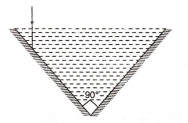 Multiple Choice Questions
Multiple Choice QuestionsThe Cauchy's dispersion formula is
n = A + Bλ-2 + Cλ-4
n = A + Bλ-2 + Cλ4
n = A + Bλ2 + Cλ-4
n = A + Bλ2 + Cλ4
The working of which of the following is similar to that of a slide projector?
Electron microscope
Scanning electron microscope
Transmission electron microscope
Atomic force microscope
A ray of light is traveling from glass to air, (refractive index of glass= 1.5). The angle of incidence is 50°. The deviation of the ray is
0°
80°
Magnification of a compound microscope is 30. The focal length of eye-piece is 5 cm and the image is formed at a distance of distinct vision of 25 cm. The magnification of the objective lens is:
6
5
7.5
10
A ray falls on a prism ABC (AB = BC) and travels as shown in the figure. The least value of the refractive index of the material of the prism should be;

1.5
1.33
A flat mirror revolves at a constant angular velocity making 2 revolutions/s. With what velocity will a light spot move along a spherical screen with a radius of 10 m if the mirror is at a centre of curvature of the screen?
251.2 m/s
261.2 m/s
271.2 m/s
241.2 m/s
A vessel consists of two plane mirrors at right angles (as shown in the figure). The vessel is filled with water. The total deviation in incident ray is

0°
90°
180°
none of these
An object is placed at a distance equal to the focal length of a convex mirror. If the focal length of the mirror is f, then the distance of the image from the pole of the mirror is :
less than f
equal to f
more than f
infinity
